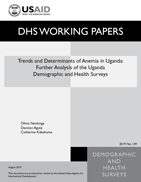There is no printed copy available to order.
Abstract:
Anemia is a public health problem in many developing countries. It affects a sizable proportion of children under age 5 and women of reproductive age. Anemia increases the risk of morbidity and mortality from infectious diseases, and can lead to poor fetal outcomes, inadequate bodily development, and low productivity. This study analyzed data from the Uganda Demographic and Health Surveys conducted in 2006, 2011, and 2016 to understand the trends and determinants of anemia in children age 6-59 months and women age 15-49. Bivariate analysis and multiple logistic regression analysis examined the association between the outcome variables and the determinants.
The results of the analysis show that anemia levels decreased in Uganda between 2006 and 2016, but with an increase between 2011 and 2016. The overall prevalence of anemia among children was 73% in 2006, 50% in 2011, and 53% in 2016. Among women, anemia prevalence was 49%, 23%, and 32% respectively in 2006, 2011, and 2006. Among the children studied, recent child sickness and maternal anemia were significantly associated with childhood anemia in all 3 years. Children who took drugs for intestinal worms had lower odds for anemia in 2006 and 2016. Household wealth, region, and maternal age were also associated with anemia in children. Women who were pregnant at the time of the survey had higher odds of being anemic across the surveys. Women in poorer households and women using non improved sources of drinking water also had higher odds for anemia. Interventions to reduce cases of anemia in children and women should address access to health care, treatment of sicknesses, improvement in household income, and women’s empowerment.
 Trends and Determinants of Anemia in Uganda: Further Analysis of the Demographic and Health Survey (PDF, 614K)
Trends and Determinants of Anemia in Uganda: Further Analysis of the Demographic and Health Survey (PDF, 614K)
